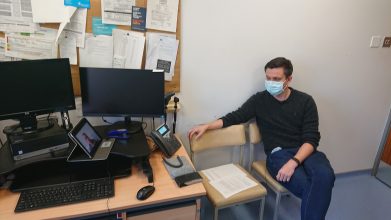
In order to prepare for the MRCGP examination, trainees must get used to reviewing their consultation recordings in order to develop the skill of self-analysis. Trainees must select cases of adequate challenge that demonstrate their suitability to be an independently practising GP in order to pass.
It can be useful to observe consultations that are not your own in order to understand what features can improve your skills. It can also be useful to understand the types of consultations that might work best as submissions.
A difficulty reported by many trainees who have already taken the examinations is that they aren’t sure what constitutes a “good” or “bad” case. No tool will ever be able to predict whether a case will or won’t be suitable, but our goal is that after analysing some standardised consultations here, trainees will have improved confidence.
We have developed 12 consultation recordings for trainees to use. We would strongly advise anyone who visits this page to read carefully to make the best use of the tool before watching/listening to any of the recordings.
Quick Links to Cases

About the RCA Calibration Tool
These simulated consultations are based on real ones, but details and elements have been changed so that they no longer link to real patients. Actors play the roles of the clinician and patient. Minor editing has taken place to make the recordings suitable for sharing, but there are no cuts or timing changes made to the consultations.
The recordings contain clinical information that may be incorrect, either at the time of recording or when accessed, due to the changing nature of medicine and science. You should not use these recordings as a substitute for your own clinical judgement and current clinical guidance when applying them to episodes of real patient care.
How to Use the Tool

The aim of the tool is to get used to analysing consultations, gain confidence in developing your own critiquing skills, and calibrate yourself against a standardised analysis.
We strongly recommend that you follow our guide to gain the most from the exercise. Once a case has been listened to, or the expert report read, the value in re-analysis is diminshed and the opportunity to use the exercise to calibrate yourself will be lost.
SCA examiners will only review a recorded case once, and we recommend following a similar approach in order to replicate the understanding of what stands out in a recording.
The Calibration tool can be used by trainees, trainers and educators.
This is not a consultation skills tool. There may be examples and elements that aid your own development, but several cases contain elements or consultation styles designed to demonstrate areas that could be improved upon. It is vital to understand that these cases do not “ideal” cases, and therefore they shouldn’t be used as a template for how to consult. Caution should also be taken following any of the consultation styles or clinical information in the cases as this may not represent best practice.
We thoroughly recommend TALC as a tool for developing excellent consultation skills. It has been developed by our colleagues and provides an in depth and structured methodology for improving the skills required to be a GP in the United Kingdom.

The 12 consultations that follow cover a mix of cases and demonstrate a variety of clinical challenge, clinical skill and consultation ability. Each case is accompanied by notes and analysis of the case from an RCA examiner. By analysing them yourself, you can then compare your analysis. Although this tool was developed for the RCA exam, the marking scheme and principles remain very similar in the SCA.
In order to get the most out of the cases, we recommend that you use either paper or digital copies of the CSA/RCA/SCA Rating Grid.
RCA RAG Rating Grid
The SCA rating grid (based on the previous CSA & RCA rating grids) is a useful tool for identifying areas of strength and weakness. A digital version of this which can be completed online and saved is also available on FourteenFish in the RCA Plus package. You can download a PDF copy below.
The SCA marking scheme uses “Clear Fail, Fail, Pass and Clear Pass” as grade descriptors and provides guidance on how candidates can generate scores using detailed examples in each of the three assessed domains (Data Gathering, Technical and Assessment Skills; Decision Making and Clinical Management Skills; and, Interpersonal Skills)
The Rating Gride uses “Red, Amber and Green” ratings in different domains that are easier to assess when reviewing your own consultations. This system has been used with demonstrable success in aiding trainees to improve the quality of their examination performance.
- A RED rating indicates a poor perfromance, such an absence of use or inappropriate use of a domain.
- A GREEN rating indicates a good performance, where the domain can be clearly seen demonstrated and used well
- AMBER ratings are where the example is neither red or green
The goal should be to identify “RED” areas, and improve these in future consultations. For the purposes of this tool, understanding what is “red” or “green” can help ensure that trainees and their supporting educators guide their training effectively.
Analysis
Once you’ve downloaded a blank template and selected a case to analyse, you are ready!
- We recommend allowing yourself at least 20 uninterrupted minutes per case in order to listen/watch without distraction.
- Watch the cases in their entirety, without pausing or rewinding. This is to replicate how the examiner would view the case (usually just once)
- Keep an eye on the timings and make notes on key moments in each consultation.
- Once a case is reviewed, grade it using the Consultation rating grid.
We encourage you to take notes, which can include (but shouldn’t be limited to):
- Timings of key events in the consultation (such as summaries or the start of plan negotiation)
- The patient idea, concern and expectation
- Clinical “red flags” asked (and those not asked)
- Phrases that work well to gather information
- Evidence of repetition/inefficiency in gathering data
- Clinical queries arising from the case
Once you’ve done this, you can then go to the individual case page to download the expert analysis report for each case, and then compare your analyses. As well as noting where you agree with the expert, pay close attention to where your scores/notes differ. This may represent an area where you could adapt your approach to analysis.
It is important to note that the expert analysis is to be used as a guide only. These cases have not gone through the same rigorous approach used in the marking of the real MRCGP examination. However, the analyses provide an indication of how a typical assessor might review and grade a case.
All cases were recorded during the COVID-19 pandemic and based on the RCA examination.
For example, you may feel a case offers a good management plan, but the experts don’t. Is this because there is missing clinical information? Is the plan patient-centred? Does the clinician use effective interpersonal skills to negotiate a plan with the patient? Understanding where you differ will help improve your ability to critique your own recordings.
You may wish to go back and review the case with a new perspective. You might also find it useful to discuss the cases with your GP Trainer and peers, to understand common areas where self-critique could be improved, and then apply this learning to your own recordings and analysis.
Further Activity
After reviewing cases, you could consider using them as a basis for role-play practice to look at how you might ask certain questions, or approach things in a different way. Trainers may wish to use cases to calibrate within a practice. If you think of other uses, please share them with us, and we can share here too!

Cases
Remember, before reading the analyses, ensure you have listened to the recording, made your own notes and completed your own assessment of the case.
Case 1
Download Case 1 MP3 here: https://drive.google.com/file/d/1CzI1FdT8IOsx1DuvR5jDmdZ3h2IoV3Ii/view?usp=sharing
Case 1 Accompanying NotesCase 2
Download Case 2 MP3 here: https://drive.google.com/file/d/1u7T-HwDPudJNXy8m8TbIk-EJhSlyOWYl/view?usp=sharing
Case 2 Accompanying Notes